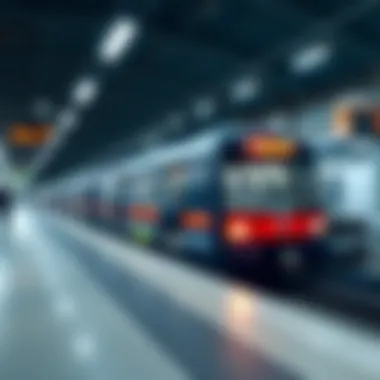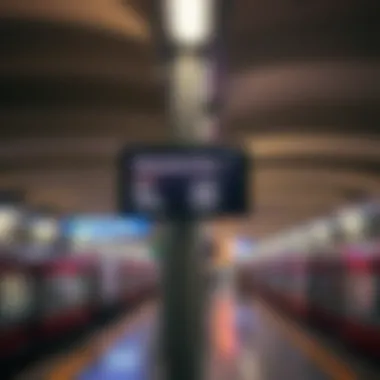Metro Train Timing in Dubai: A Complete Guide


Intro
Navigating a bustling city like Dubai can be a feat in itself, especially for those who are new to its intricacies. One significant advantage this metropolis offers its residents and visitors alike is its metro train system, a lifeline that stitches together various parts of the city. Understanding the timing, operational hours, and service frequency of the metro trains is essential for efficient commuting. This guide serves as a comprehensive resource aimed at property enthusiasts, investors, and expats, assisting them in optimizing their travel plans throughout this vibrant city.
Market Trends and Insights
Current Trends in Dubai Real Estate
As the real estate landscape in Dubai evolves, several significant trends are emerging. For starters, an increasing number of residential properties are being developed around metro stations. This trend is not merely by chance; developers recognize that proximity to reliable public transport can significantly enhance a property's value.
For instance, areas near the Mall of the Emirates and Burj Khalifa have seen a considerable uptick in both rental and purchase prices, as people gravitate towards the convenience provided by the metro. With the launch of new metro lines, further growth in these hotspots is expected.
Additionally, eco-friendly designs are gaining traction. Green building certifications and sustainable living solutions are increasingly becoming attractive features for homebuyers and investors alike. Government initiatives promoting smart city solutions and sustainable transport systems further amplify this shift.
Predictions for Future Market Developments
Looking ahead, experts predict that the real estate market in Dubai will continue to flourish, particularly in areas served by the metro. The forthcoming Expo 2025 and the associated infrastructural developments will likely act as a catalyst for further growth. As more international businesses set up shop in Dubai, demand for housing near metro stations will likely intensify.
Furthermore, innovations in smart transport solutions could introduce elements like predictive scheduling—or possibly real-time updates about train timings—making commuting even more straightforward. This prospective evolution underscores the importance of being well-acquainted with metro timing for individuals planning their living situations in relation to their daily commutes.
"Metro timing not only dictates the rhythm of daily life but also mirrors the dynamic expanse of Dubai’s real estate market."
Overall, staying updated on market trends is crucial for discerning investors, homebuyers, and expats looking to navigate Dubai’s vibrant landscape efficiently. The interplay between metro service timing and property values can unlock insights that may have significant financial implications.
Luxury Developments and Properties
Spotlight on Iconic Developments
In the realm of luxury properties, several developments stand out due to their strategic location near metro stations. The Burj Crown and the Dubai Creek Tower are examples where opulence meets convenience. Properties in these developments are not only aesthetically appealing but also stand to gain from the increasing foot traffic due to their proximity to metro stations.
Investments in these iconic buildings can yield good returns, especially as tourism continues to rise post-pandemic. A clever buyer needs to look beyond just the immediate benefits and consider long-term developments that can accentuate property values.
Investing in Luxury Properties: A Guide
When considering investments in luxury properties, timing is everything.
Here are a few points to ponder:
- Understand the Metro's Role: Properties adjacent to metro stations are often front-runners in terms of value.
- Stay Updated on Developments: Frequenting local real estate events or following real estate forums can keep you abreast of what's happening in the area.
- Be Aware of Cultural Nuances: Different cultures have varying takes on luxury. What might appeal to a local might not resonate with an expat. An understanding of these nuances can make a significant difference.
It’s clear that the timing of metro services is not an isolated aspect; it interlinks with market trends, investment opportunities, and even lifestyle choices in the luxurious fabric of Dubai's real estate sector. Keeping a keen eye on metro train timings helps in making knowledgeable decisions that align with individual commuting patterns and ambitions.
Overview of Dubai's Metro System
Dubai's Metro system is more than just a mode of transportation; it's a lifeline that weaves together the fabric of a vibrant, swiftly evolving metropolis. Recognizing the crucial role that efficient public transport plays in any urban landscape, the Dubai Metro was conceived not only to alleviate traffic congestion but to foster economic growth, tourism, and a sustainable living environment. This article sheds light on the foundational elements and substantial benefits of this incredible system, particularly for those who may be new to the city or are exploring investment opportunities in the dynamic real estate arena.
Historical Context of Metro Development
The inception of the Dubai Metro can be traced back to the early 2000s, during a period of rapid development and urban expansion. The need for a structured transport framework became undeniable as the city experienced exceptional population growth. Spearheaded by the Dubai Roads and Transport Authority (RTA), the project launched in 2006, creating a landmark that would set a precedent for public transit systems in the region. The first lines opened in 2009, connecting essential residential and commercial areas, and establishing a foundation for what would become one of the longest automated metro systems in the world.
Understanding the historical context of the Metro's development illuminates its imperative role in shaping the city’s infrastructure. The transformation of Dubai from a small trading port into a bustling global city necessitated forward-thinking transport solutions. This foresight is commendable and highlights Dubai's long-term vision for transportation efficiency.
Geographical Reach and Coverage
The geographical reach of the Dubai Metro is extensive, covering a whopping 90 kilometers across multiple lines. Two primary lines, the Red Line and the Green Line, serve the city, touching key areas such as Dubai Marina, Burj Khalifa, and Dubai International Airport.
- Red Line: Predominantly used for longer routes, the Red Line spans approximately 52 kilometers and includes 29 stations. It plays a vital role in connecting various districts and business hubs.
- Green Line: The Green Line, on the other hand, covers about 23 kilometers with 20 stations, mainly serving the older parts of the city, and providing essential access to the heritage sites and several residential areas.
Moreover, the Metro connects with several other means of transportation, including buses, water taxis, and trams, creating a cohesive network that makes commuting seamless.
As the system continues to expand with new stations and future lines planned, the metro is poised to not only cater to the current population but also to accommodate the influx of international visitors and expatriates drawn to Dubai’s unique lifestyle.
Overall, the Dubai Metro stands as a beacon of innovation, enabling urban mobility while simultaneously enhancing the attractiveness of the city for business and leisure. Whether for investors eyeing the real estate market or expats considering relocation, understanding the Metro system's historical and geographical context gives critical insights into the city's pulse.
Metro Operational Hours


Understanding metro operational hours is vital for anyone traversing Dubai’s bustling landscape. It can greatly enhance your travel experience, whether you are a resident deeply acquainted with the city's rhythm or a tourist eager to explore its gems. The operational hours dictate when the metro is available, influencing plans and decisions for both leisure and business travel.
The significance of knowing the operational hours goes beyond mere convenience. It aids in avoiding unexpected surprises that could lead to delays or missed opportunities. Especially for those juggling busy schedules, clarity on metro timings ensures you remain on the ball. Aspects like rush hour dynamics, late-night travel options, and weekend schedules shape your ability to navigate the city effectively.
The metro's operational hours offer some distinct benefits. For instance, having a clear outline of when trains run can save precious time, allow for seamless connections between destinations, and even reduce travel costs by optimizing your trip lengths.
"Timing is everything in this fast-paced city. Understanding when the metro operates facilitates smooth transitions for both daily commuters and visitors alike."
Weekday Schedule
On weekdays, the metro service operates at varied timings, catering to the morning rush and later evening commutes. Generally, trains kick off around 5 a.m. and run until midnight, though this can vary based on specific stations and any public holidays.
- Peak Hours: The morning peak typically sees high passenger volumes between 7 a.m. and 9 a.m. Here, trains run more frequently. This frequency will often decrease throughout the day, returning to a more regular schedule around late afternoon.
- Midday and Evening: Midday service tends to hover around a 10 to 15-minute interval. Meanwhile, evening peak hours can stretch from around 5 p.m. to 8 p.m., at which point the frequency usually spikes to accommodate the commuting crowd heading home.
Understanding this schedule helps in planning one's journey better. If you can avoid the crush during peak times, you'd not only enjoy a more comfortable ride but might also find it easier to catch connecting transport.
Weekend Schedule
The weekend sees a slight shift in operational hours as compared to weekdays. While the metro remains operational to cater to leisure travelers and shoppers, the overall frequency might be more relaxed.
- Saturday and Sunday: Generally, the metro operates from 5 a.m. to 1 a.m. the following day. However, expect a more spacious atmosphere on weekend trains due to reduced commuter traffic, thus allowing for a more leisurely experience.
- Frequency Adjustments: During these days, the metro trains often run less frequently, typically every 10 to 20 minutes. Thus, while you may have more freedom to enjoy the city’s attractions, it's essential to keep this in mind when planning outings.
In sum, understanding the operational hours provides a sturdy foundation for navigating Dubai via its metro system. Adapting to these schedules can positively impact your overall experience, whether commuting to work or leisurely exploring the vibrant attractions Dubai has to offer.
Frequency of Metro Services
Navigating Dubai's bustling urban landscape is often tightly intertwined with the frequency of metro services. This factor influences not just convenience, but also commuter satisfaction. The metro system, like a well-oiled machine, aims to accommodate the varying demands of its users, providing swift and efficient connectivity throughout the city. Understanding how often the trains run during peak and off-peak periods can be the difference between smooth sailing and a frustrating commute.
Peak Time Frequencies
During peak hours, the metro trains operate on a more frequent schedule. Mornings, specifically from 7 AM to 9 AM, and evenings from 5 PM to 8 PM are when most commuters are hustling to and from work. The high demand during these hours prompts the service to ramp up its frequency.
You can typically expect trains arriving as frequently as every 2 to 4 minutes. Such tight intervals help to minimize wait times for passengers, making it easier to hop on and reach their destinations without a hitch. For instance, during the busier months, these frequencies might become even tighter, accommodating the large influx of residents and tourists alike, especially around major hubs like the Burj Khalifa or malls.
Here are some key points regarding peak time frequencies:
- Trains run at intervals of 2 to 4 minutes.
- Ideal for commuters heading to business districts.
- Helps reduce the overcrowding that often occurs during rush hours.
Off-Peak Frequencies
Conversely, during off-peak hours, the train schedules adapt accordingly. These periods generally fall outside the morning and evening rush, typically between mid-morning and late afternoon, as well as late at night.
During these times, trains may arrive every 7 to 10 minutes. While the frequency drops, it still maintains a reliable service, ensuring that those with flexible schedules or late-night activities are not left in the lurch. It’s also essential for expats and international visitors who may be exploring different parts of the city without the pressure of rush hour.
Key factors about off-peak frequencies include:
- Longer intervals, typically 7 to 10 minutes between trains.
- Suitable for leisure travel and casual commuting.
- Allows for a more pleasant, less crowded experience.
Understanding peak and off-peak frequencies helps users plan their routes more effectively, ensuring they can navigate Dubai's metro system with confidence. This knowledge is invaluable, particularly for investors and expats who rely on efficient transportation for work and leisure activities.
"A reliable metro system is the backbone of any vibrant city, influencing not just commute times but overall quality of urban life."
By being aware of these schedules, you position yourself to take full advantage of what Dubai's infrastructure has to offer. Consider checking the latest timings and updates through the metro's official apps or websites to stay ahead of the game. **Resources such as Dubai Metro and forums like Reddit can provide additional insights to help optimize your commuting strategy.
Factors Influencing Train Timing
Understanding train timings in Dubai's metro system goes beyond just looking at a timetable. The timing of metro trains is influenced by various factors that significantly affect the passenger experience and operational efficiency.
Passenger Demand and Usage Patterns
The first element that comes into focus is passenger demand. Dubai has a bustling population and attracts millions of tourists every year. This influx creates varying usage patterns. For instance, during weekday mornings, many commuters are heading to work, leading to a sharp rise in passenger volumes. Conversely, afternoons might see a drop in the number of commuters as some people choose to return home later.
Commuters flow in different directions: tourists visiting attractions, residents commuting to work, and students heading to universities. Metro services must adjust to these changing patterns. The number of trains running during peak hours is usually higher compared to off-peak times.


It’s also observed that holiday periods, such as Eid or the Dubai Shopping Festival, can dramatically shift expected patterns. Marks in usage patterns can lead to temporary adjustments that, while they might seem minor, can result in significant overall improvements in commuter experience.
"Timely adjustments to service frequency based on passenger patterns can make a world of difference, ensuring that everyone gets where they're going without unnecessary waits."
Maintenance Schedules and Interruptions
Another crucial aspect affecting train timings is the maintenance schedules. Just like any other extensive public transportation system, the Dubai Metro requires regular upkeep to ensure safety and reliability. Maintenance work often happens during quieter times, such as late at night or during certain off-peak hours. This careful planning aims to cause as little disruption as possible to frequent users while ensuring the system operates smoothly.
However, unplanned interruptions can occur due to unexpected mechanical issues or accidents, necessitating immediate attention. In such cases, real-time information becomes invaluable. The metro management usually communicates these interruptions swiftly through various channels to keep passengers informed.
Investors and realtors naturally watch these maintenance practices closely. Properties near metro stations can lose or gain value based on how well-maintained the metro services are. A good maintenance record contributes to a positive perception of the metro system and, by extension, the surrounding neighborhoods.
In summary, both passenger demand variations and maintenance schedules play critical roles in shaping the operation of Dubai's metro train timing. By recognizing these factors, users can strategize their visits and planning better, ensuring a smoother commuting experience.
Understanding the Timing System
Understanding the timing system of Dubai's metro network is essential for anyone navigating the bustling city. This part shines a light on how effective time management correlates with the overall transit experience. Efficient scheduling and real-time updates not only enhance commuter convenience but also promote a more organized and sustainable public transport system.
The timing system takes into account various factors like passenger demand, train maintenance, and technological innovations. When a person checks the metro timings, they access valuable insights that can significantly impact their travel plans. For instance, knowing when trains run more frequently during peak hours enables commuters to avoid long waits and crowded cars. This knowledge offers substantial peace of mind for investors, homeowners, or expats trying to fit limited time schedules into their daily lives.
Moreover, the reliability of information from the timing system helps in structuring commutes effectively. Having real-time data readily available can translate to better property investment decisions as well, as proximity to timely public transport may raise property values.
Real-Time Updates and Information
Real-time updates play an integral role in enhancing the efficiency of Dubai's metro system. Commuters now live in a digital age, where instant information is expected. The metro's real-time tracking system updates passengers about delays, arrival times, and service disruptions almost instantaneously.
This element is particularly beneficial during peak travel hours, when every minute counts. Imagine planning your journey but finding out just before boarding that your train is delayed due to unforeseen circumstances; such information can save you from wasted time and unanticipated stress. The real-time apps or screens in stations display crucial updates that travelers can’t afford to overlook.
- Benefits of Real-Time Updates:
- Enhanced decision-making on the go.
- Reduced waiting times.
- Improved overall commuter satisfaction.
"Having real-time information at your fingertips helps you make smarter choices during your commute, proving to be invaluable in an urban setting like Dubai."
Mobile Applications and Their Usefulness
Mobile applications have revolutionized how commuters engage with metro train timings. These tools are not just handy but also essential in a city where the pace of life accelerates by the minute. From Dubai's official RTA Metro app to third-party applications, these digital platforms provide extensive features which significantly contribute to a better commuting experience.
Through these apps, residents can easily track train schedules, get alerts about delays, and even find out the most efficient routes. Furthermore, many of these applications offer integrated maps and navigation tools, enhancing the travel experience from point A to B.
- Key Features of Useful Metro Apps:
- Train schedule tracking.
- Push notifications for real-time updates.
- User reviews and feedback on service quality.
In essence, leveraging such technology means commuters can plan their trips with precision. This level of convenience is likely to play a key role in shaping the overall perceptions and experiences of the metro system.
By marrying efficient timing systems with accessible mobile technology, Dubai advances as a city embracing modernity while addressing the needs of its diverse populace. The integration of technology not only aids in seamless operations but also stimulates a thriving community of real estate investors, homeowners, and newcomers seeking to navigate the metro landscape efficiently.
Impact of Metro Timing on Daily Life
Metro train timing in Dubai significantly shapes the daily experiences of its residents and visitors. Whether one is rushing to work, heading to meet friends, or simply exploring the city, knowing when trains operate is essential for efficient travel. Not only does this influence individual journeys, but it also has broader implications for community connectivity and urban planning.
Convenience for Commuters
For commuters, the timing of metro trains marks the difference between a smooth ride or a frustrating delay. The Dubai Metro operates with a frequency that caters to most schedules, but understanding peak and off-peak services can make all the difference. During peak hours, trains can become crowded, which may lead to longer wait times due to the volume of travelers.
Let’s consider a typical morning for a professional heading into the city center. If they catch the train around 8 AM, they may find themselves squeezed into a crowded carriage, shoulder to shoulder with other passengers. However, if they manage to plan their commute around 10 AM, they might find a calmer train, enabling them to read or catch up on emails during their ride.
This trend holds across various demographics. Evacuating commuters to arrive at their destinations promptly lessens the stress of urban transportation. Moreover, for those utilizing the metro to connect to other areas, knowing the exact timing can optimize their travel experience. Real-time updates and handy mobile applications play a critical role in this sphere, allowing commuters to make informed decisions about their routes.
Economic Effects on Property Value
On a broader scale, metro timing can have profound economic effects, especially on property values in Dubai. Real estate markets often flourish near convenient transport systems. Properties located within walking distance of metro stations typically see higher demand. Investors and homebuyers recognize that quick access to public transport routes enhances property attractiveness.


The metro effectively connects residential areas with bustling commercial districts, thereby increasing property value. Neighborhoods like Dubai Marina and Jumeirah Lakes Towers have experienced noticeable growth in real estate prices, thanks in part to their proximity to metro stations. This is not just about convenience; it also reflects a lifestyle choice that many buyers today are looking for.
In addition, the integration of metro timing into planning discussions can influence future urban development projects, as developers understand the need to create environments where residents are not solely reliant on personal vehicles. In essence, with an efficient metro system, areas once overlooked can become desirable hotspots for living and working.
"Metro systems do not just move passengers; they create economic flows and enable communities to thrive."
Therefore, the impact of metro timing is not just a personal convenience; it resonates throughout the fabric of Dubai's economic landscape. As the city continues to evolve, so will perceptions of property values based on transit accessibility, setting the stage for future investments and urban planning endeavors.
Challenges in Metro Operations
The operational efficiency of Dubai's metro system is crucial not only to daily commuters but also to the broader economic landscape. Understanding the challenges faced in this aspect provides insights into how effectively the metro can serve its growing population amidst increasing demand. These challenges can greatly influence planning and investment decisions, highlighting the immediate need to address operational hiccups.
Delays and Service Interruptions
Delays in metro services can throw a wrench into the daily plans of commuters. Factors contributing to this may range from technical glitches in the system to unexpected issues such as accidents or malfunctions on the tracks. These interruptions can lead to a cascade of inconveniences for passengers, often leaving them scrambling for alternative transport options.
"An unplanned delay not only affects the rider's journey but ripples across the entire network, disrupting schedules and causing frustration among others waiting for trains."
In peak hours, when the system is already under tremendous pressure, these delays can multiply exponentially. Commuters might find themselves packed like sardines in carriages, waiting longer than anticipated for their next train. Each minute can feel like an eternity when you need to reach an important meeting or appointment. Even worse, regular delays might deter potential users from relying on the metro system, steering them back to their cars and adding to the congestion on roadways.
Passenger Experience During Downtime
Service interruptions lead not only to logistical challenges but also impact the overall experience of the passenger. Individuals stuck on a metro platform during downtime can feel a mix of confusion and anxiety, particularly if real-time updates are not communicated efficiently. A delay could transform an efficient public transport day into chaos.
An empty train station can suddenly feel hostile. Riders may find themselves in a concerning state, wondering about safety and the reliability of the whole metro system. The vibe during these times can be hard to ignore. It’s not just about being late; it’s about the uncertainty that delays create.
The metro authorities have taken steps to mitigate these experiences, such as providing real-time information via their mobile application. But challenges do persist. Simple communication can go a long way in changing the atmosphere: without regular updates, riders are left in the dark, raising questions about the management of the metro service.
Future Developments in Metro Timing
The future of Dubai's metro timing is set to unfold in intriguing ways, presenting opportunities to enhance both efficiency and user experience. With the city continuing to expand rapidly, there’s an imperative to adapt and improve the metro system's schedule and operations. Understanding these future developments is essential for everyone—from daily commuters to investors and city planners. As urban landscapes evolve, so too must public transportation capabilities to ensure they meet the changing needs of the population.
Proposed Extensions and Improvements
Dubai is continuously on the move, and that includes the metro system. Proposed extensions aim to stretch the metro lines to newly developing districts and areas experiencing a surge in population growth. These extensions will connect key residential neighborhoods with commercial hubs and tourist attractions, enhancing accessibility.
- Potential New Lines: There are talks of adding lines that reach areas like Dubai South, where many major projects, including Expo 2020-related developments, are taking place.
- Improved Access: Additional stations are planned along existing lines to better serve burgeoning communities, thus making travel seamless for residents.
- Increased Capacity: With these improvements and expansions, the metro aims to accommodate a higher volume of passengers without compromising speed or comfort.
Such enhancements not only provide practical benefits for commuters but also hold potential economic advantages by increasing property values in surrounding areas. The connection of new venues to the metro system typically leads to increased foot traffic and vibrancy in those locales.
Technological Innovations in Scheduling
In tandem with physical extensions, the integration of technology into the scheduling of metro services holds promising prospects. Innovations in real-time data handling and AI-driven analytics already play a significant role in modern urban transport systems. For Dubai’s metro, this could mean ushering in a new era of reliability and user-friendly experience.
- AI and Predictive Analytics: Leveraging artificial intelligence to analyze ridership patterns could optimize train frequency during peak hours. By predicting busy travel days and adjusting the timetable accordingly, it could help manage crowding effectively.
- Enhanced Real-Time Updates: Innovations can provide passengers with up-to-the-minute transit information, helping them plan their trips with confidence.
- Seamless Payment Systems: Upgrading ticketing systems to incorporate contactless payment technologies, such as mobile wallets, can streamline the boarding process, reducing delays.
Investments in these technological advancements indicate a commitment not only to keeping pace with increasing demand but also to enhancing the overall commuter experience. While the focus is on future plans, it’s clear that improvements in technology will play a fundamental role in shaping how efficiently and effectively the metro system operates.
"Improving metro services is not just about infrastructure; it’s about creating a harmonized experience for residents and visitors alike, showcasing the heart of Dubai as a global metropolis."
The strategic plans for future developments underscore a commitment to continuous improvement. Property investors, homebuyers, and redevelopment professionals should watch closely as these changes unfold, not only because they influence transit operations but also because they can significantly affect property values and community livability.
How to Navigate the Metro Timings
Navigating the metro train timings in Dubai can indeed be a game-changer, especially for those living or working in the city. As one of the fastest-growing urban cities, Dubai's metro system has become integral to its public transport framework. The importance of knowing how to effectively plan your trips cannot be overstated. Understanding the timings allows commuters to avoid the rush, make informed decisions about travel routes, and ultimately enhance their daily experiences.
Best Practices for Planning Commutes
When it comes to maximizing efficiency while using the metro, applying some best practices can substantially ease the pain of daily commutes. Here are some strategies that may help:
- Check the Metro Schedule: Before heading out, check the official RTA website or use the latest mobile apps to see the current timetable. This helps prevent any surprises.
- Consider Peak Hours: Plan your travel outside of peak hours whenever possible. Typically, morning rush starts from around 7 AM to 9 AM and evening rush from 5 PM to 8 PM. During these times, trains can be packed like sardines!
- Allow Extra Time: Give yourself some leeway in case of unforeseen delays. It’s wise to arrive early, especially if you have important appointments.
- Use the Nearest Station: Identify the station closest to your home or workplace for convenience. This can save you essential travel time.
- Connect with Other Modes of Transport: Knowing how the metro integrates with bus services or tram lines can create a seamless transit experience. For example, if you hop off at Burjuman Station, you can easily transfer to the bus service that heads to Al Ghurair Centre.
By implementing these practices, commuters can navigate Dubai's metro system with greater competency and ease.
Utilizing Available Resources and Tools
Navigating metro timings can be made notably more manageable by leveraging a variety of resources and tools available at your disposal. Consider the following:
- Mobile Applications: Apps such as RTA Dubai allow users to see real-time train timings. With its map feature, users can also check in which direction to head, making it a handy companion on the go.
- Online Resources: Websites like wikipedia.org offer insights into Dubai's metro project, including future expansions and operational details. Also, checking out the RTA’s official site provides up-to-date information on fare changes and service disruptions.
- Feedback Forums: Platforms like reddit.com often have threads where residents share first-hand experiences, tips, or even raised concerns regarding the metro services. This can offer a snapshot of current user experiences.
- Social Media: Following RTA on platforms like facebook.com can keep you informed of any unexpected delays or issues, ensuring you’re always in the loop.
By utilizing these tools, commuters can enjoy a smoother experience navigating the often busy metro system in Dubai. Knowledge is power, and having a firm grasp of available resources ensures that you’re always ready to tackle the challenge of commuting.















